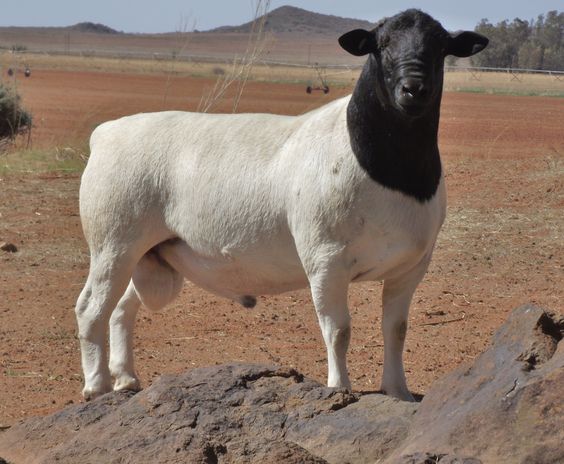THE Dorper is the result of one of the most successful long-term livestock improvement programmes in South Africa. During the 1930s it became clear that a new breed was needed that could produce a carcass of high quality in the dry areas of South Africa.
Persian and Dorset Horn sheep were crossed and evaluated in a series of cooperative trials with the Department of Agriculture (Grootfontein) and sheep farmers in the Northern Cape between 1933 and 1946.
Their aim was to develop a hardy mutton sheep capable of surviving, reproducing and producing fast-growing lambs off the veld in the low rainfall areas of the country.
Description
Dorpers: A white sheep with black confined to the head and neck is the ideal. Black spots, to a limited extent on the body and legs are permissible, but an entirely white sheep or a sheep predominantly black is undesirable. Brown hair around the eyes, white teats, white under the tail and white hoofs are undesirable. White Dorpers: A white sheep, fully pigmented around the eyes, under the tail, on the udder and the teats is the ideal. A limited number of other coloured spots is permissible on the ears and underline.
A sheep with a good weight for its age is the ideal. Discrimination against extremely small or extremely big animals must be exercised. Too much localisation of fat on any part of the body is undesirable.
The ideal cover is a short, loose, light covering of hair and wool with wool predominating on the forequarter and with a natural clean kemp underline. Too much wool or hair is undesirable. Exclusively wool or hair is a fault. Manes are a disqualifier.
Young ewes could be mated for the first time at seven months of age, depending on the environment and their body weight at that age. Young Dorper ewes mated at seven months of age at an average weight of 40 kg at Carnarvon Experimental Station had a conception rate of 65% and weaning percentage of 60%.
• Meat – The Diamond Dorper trademark guarantees tender and juicy meat on a well-rounded carcass with fairly lean to medium fat covering.
• Skins – The skin of the Dorper has no creasing and has a smooth grain. It is used for the production of high quality clothing and gloves. These skins are a sought after export product and few are used in the local industry.
• Arid to semi-arid grassveld and savannah grassveld.
• Originally bred for the dry areas, but is successfully farmed with across the country as well as outside our borders.
• The majority of Dorper sheep occur in the more arid areas of the country (Karoo, Kalahari). They do, however, occur across the country as a whole. – www.dorpersa.co.za/info/breedstandards
Stay informed with The Namibian – your source for credible journalism. Get in-depth reporting and opinions for
only N$85 a month. Invest in journalism, invest in democracy –
Subscribe Now!






